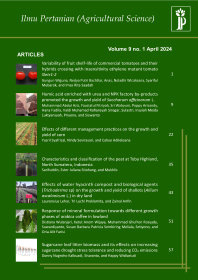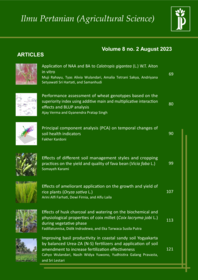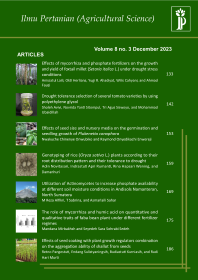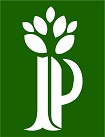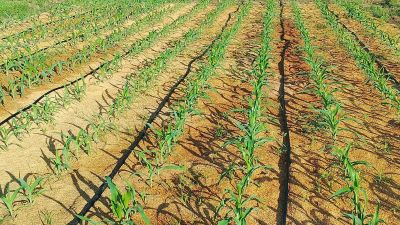
Effects of different management practices on the growth and yield of corn
Yusril Syafrizal(1), Nindy Sevirasari(2*), Cahyo Adileksana(3)
(1) Edufarmers International Foundation
(2) Edufarmers International Foundation
(3) Edufarmers International Foundation
(*) Corresponding Author
Abstract
In Indonesia, corn is an important commodity that serves as the second source of carbohydrates after rice, whose productivity is influenced by management practices applied during cultivation. This research aimed to determine the effects of different management practices on the growth and yield of corn. This research was arranged in a single-factor Randomized Complete Block Design, with different agriculture management practices as treatments, consisting of TI1 = Best Practices (Drip Irrigation + Rice Husk + Mycorrhiza), TI2 = Farmers’ Practices (Furrow Irrigation) + Mycorrhiza, and TI3 = Farmers’ practices (Furrow Irrigation). The data observed were analyzed using Analysis of Variance and followed by the Post Hoc Tukey’s HSD at α= 5%. The results showed that the TI1 produced significantly higher plant height, stem diameter, leaf dry weight, weight of cob with cornhusk and kernel dry weight, and effectively suppressed weed growth compared to TI2 and TI3. TI1 produced a significantly higher number of leaves, root dry weight, and total dry weight compared to TI3, but not significantly different compared to TI2. TI1 produced not significantly different stem dry weight and harvest index compared to TI2 and TI3. The kernel dry weight per plant observed in TI1 was 157.63 g, which was 14.22% and 22.91% higher than in TI2 and TI3, respectively. Based on the coefficient correlation and path analysis, the number of leaves, plant height, and total dry weight should be considered as important plant growth variables to produce high kernel dry weight.
Keywords
Full Text:
PDFReferences
Agbodjato, N.A., Assogba, S.A., Babalola, O.O., Koda, A.D., Aguégué, R.M., Sina, H., Dagbénonbakin, G.D., Adjanohoun, A., and Baba-Moussa, L. (2022). Formulation of Biostimulants Based on Arbuscular Mycorrhizal Fungi for Maize Growth and Yield. Frontiers in Agronomy, 4, pp. 1–15.
Ahmadi, S.H., Ghasemi, H., and Sepaskhah, A.R. (2020). Rice Husk Biochar Influences Runoff Features, Soil Loss, and Hydrological Behavior of A Loamy Soil in a Series Of Successive Simulated Rainfall Events. Catena, 192, pp. 1–13.
Alhashimi, A., AL-Huqail, A., Hashem, M., Bakr, B., Fekry, W., Abdel-Aziz, H., Hamdy, A., Abdelraouf, R., and Fathy, M. (2023). Using Deficit Irrigation Strategies and Organic Mulches for Improving Yield and Water Productivity of Mango under Dry Environment Conditions. Agriculture, 13(7), pp. 1–21.
Araujo, D.F., Costa, R.N., and Mateos, L. (2019). Pros and Cons of Furrow Irrigation on Smallholdings in Northeast Brazil. Agricultural Water Management, 221, pp. 25–33.
Aristya, V.E., and Samijan, S. (2022). The Yield Gap Maize under Intensive Cropping System in Central Java. Planta Tropika: Jurnal Agrosains (Journal of Agro Science), 10(1), pp. 1–12.
Artiola, J. F. (1991). Nonuniform leaching of nitrate and other solutes in a furrow-irrigated, sludge amended field. Communications in Soil Science and Plant Analysis, 22(9–10), pp. 1013–1030.
Asres, L.A. (2023). Alternative Techniques of Irrigation Water Management for Improving Crop Water Productivity. Reviews in Agricultural Science, 11, pp. 36–53.
Begum, N., Qin, C., Ahanger, M. A., Raza, S., Khan, M. I., Ashraf, M., Ahmed, N., and Zhang, L. (2019). Role of Arbuscular Mycorrhizal Fungi in Plant Growth Regulation: Implications in Abiotic Stress Tolerance. Frontiers in Plant Science, 10(September), pp. 1–15.
Bharati, S., Joshi, B., Dhakal, R., Paneru, S., Chandra Dhakal, S., and Raj Joshi, K. (2019). Effect of Planting Depth and Mulching Materials on Yield and Yield Attributes of Potato in Dadeldhura, Nepal. Acta Scientific Agriculture, 3(10), pp. 131–140.
Bhasker, P., Singh, R. K., Gupta, R. C., Sharma, H. P., and Gupta, P. K. (2018). Effect of drip irrigation on growth and yield of onion (Allium cepa L.). Journal of Spices and Aromatic Crops, 27(1), pp. 32–37.
Buzo, F. de S., Garcia, N.F.S., Garé, L.M., Gato, I.M.B., Martins, J.T., Martins, J.O.M., Morita, P.R. de S., Silva, M.S.R. de A., Sales, L.Z. de S., Nogales, A., Rigobelo, E.C., and Arf, O. (2022). Phosphate Fertilization and Mycorrhizal Inoculation Increase Corn Leaf and Grain Nutrient Contents. Agronomy, 12(7), pp. 1–14.
Compant, S., Samad, A., Faist, H., and Sessitsch, A. (2019). A Review on the Plant Microbiome: Ecology, Functions, and Emerging Trends in Microbial Application. Journal of Advanced Research, 19, pp. 29–37.
Deng, Q., Wu, Y., Zhao, X., Qiu, C., Xia, S., Feng, Y., and Liu, H. (2022). Influence of Different Irrigation Methods on the Alfalfa Rhizosphere Soil Fungal Communities in an Arid Region. PLoS ONE, 17(6), pp. 1–18.
Dini, A.Z., Yuwariah, Y., Yulianto, W.F., and Ruswandi, D. (2018). Growth and Yield of Maize (Zea mays L.) under Intercropping with Sweet Potato (Ipomoea batatas (L.) Lam) in Arjasari Bandung Regency. Jurnal Agrotek Indonesia, 3(2), pp. 113–120.
Farjon, G., Itzhaky, Y., Khoroshevsky, F., and Bar-Hillel, A. (2021). Leaf Counting: Fusing Network Components for Improved Accuracy. Frontiers in Plant Science, 12, pp. 1–12.
Henry, W.B. and Krutz, L.J. (2016). Water in Agriculture: Improving Corn Production Practices to Minimize Climate Risk and Optimize Profitability. Current Climate Change Reports, 2(2), pp. 49–54.
Hsieh, C.Y., Fang, S.L., Wu, Y.F., Chu, Y.C., and Kuo, B.J. (2021). Using Sigmoid Growth Curves to Establish Growth Models of Tomato and Eggplant Stems Suitable for Grafting in Subtropical Countries. Horticulturae, 7(12), 537.
Huey, C.J., Gopinath, S.C.B., Uda, M.N.A., Zulhaimi, H.I., Jaafar, M.N., Kasim, F.H., and Yaakub, A.R.W. (2020). Mycorrhiza: A Natural Resource Assists Plant Growth under Varied Soil Conditions. 3 Biotech, 10(5), pp. 1–9.
Irmak, S., Mohammed, A.T., and Kukal, M.S. (2022). Maize Response to Coupled Irrigation and Nitrogen Fertilization Under Center Pivot, Subsurface Drip and Surface (Furrow) Irrigation: Growth, Development and Productivity. Agricultural Water Management, 263, pp. 1–53.
Jalal, A., Oliveira, C.E. da S., Rosa, P.A.L., Galindo, F.S., and Teixeira Filho, M.C.M. (2023). Beneficial Microorganisms Improve Agricultural Sustainability under Climatic Extremes. Life, 13(5), pp. 1–23.
Karimi, B., Cahurel, J.Y., Gontier, L., Charlier, L., Chovelon, M., Mahé, H., and Ranjard, L. (2020). A Meta-analysis of the Ecotoxicological Impact of Viticultural Practices on Soil Biodiversity. Environmental Chemistry Letters, 18(6), pp. 1947–1966.
Koca, Y.O., and Erekul, O. (2016). Changes of Dry Matter, Biomass and Relative Growth Rate with Different Phenological Stages of Corn. Agriculture and Agricultural Science Procedia, 10, pp. 67–75.
Liu, M., Wang, G., Liang, F., Li, Q., Tian, Y., and Jia, H. (2022). Optimal Irrigation Levels Can Improve Maize Growth, Yield, and Water Use Efficiency under Drip Irrigation in Northwest China. Water (Switzerland), 14(23), 3822.
Ma, H., Yang, T., Niu, X., Hou, Z., and Ma, X. (2021). Sound Water And Nitrogen Management Decreases Nitrogen Losses from a Drip-Fertigated Cotton Field in Northwestern China. Sustainability (Switzerland), 13(2), pp. 1–13.
Ma, J., Wang, W., Yang, J., Qin, S., Yang, Y., Sun, C., Pei, G., Zeeshan, M., Liao, H., Liu, L., and Huang, J. (2022). Mycorrhizal Symbiosis Promotes the Nutrient Content Accumulation and Affects the Root Exudates in Maize. BMC Plant Biology, 22(1), pp. 1–13.
Miceli, A., Vetrano, F., Torta, L., Esposito, A. and Moncada, A. (2023). Effect of Mycorrhizal Inoculation on Melon Plants under Deficit Irrigation Regimes. Agronomy, 13(2), pp. 1–22.
Muslimah, Y., Lizmah, S. F., Harahap, E. J., Jasmi, and Alfatah, M. (2022). The effect of drip irrigation on the growth of two varieties of sweet corn (Zea mays L.). IOP Conference Series: Earth and Environmental Science, 977(1), pp. 1–8.
Nasution, I.S., Satriyo, P., Ichwana, Yolanda, S., and Alma, A. (2021). Non-destructive Measurement of Leaf Area and Leaf Number of Hydroponic Pak-Choy Plants (Brassica rapa). IOP Conference Series: Earth and Environmental Science, 644(1), pp. 1–9.
Nurjanah, U., Setyowati, N., Prasetyo, P., Fahrurrozi, F., and Muktamar, Z. (2021). Weed Growth and Sweet Corn Yield as Affected by Planting Patterns and Mulch Types in Organic Farming Practice. IOP Conference Series: Earth and Environmental Science, 694(1), pp. 1–7.
Pedroso, R.M., Medeiros, C.A., Ometto, A., Paes, V., de Andrade, E.F., Inman, S., da Silva, J.R., and Pedroso, G.M. (2022). In-furrow Application of Arbuscular Mycorrhizal Fungi Propagules Enhanced Yields, Plant Vigor, and Biomass Accumulation of Soybeans (Glycine max) and Maize (Zea mays). Australian Journal of Crop Science, 16(5), pp. 657–664.
Pérez-Harguindeguy, N., Díaz, S., Garnier, E., Lavorel, S., Poorter, H., Jaureguiberry, P., Bret-Harte, M.S., Cornwell, W.K., Craine, J.M., Gurvich, D.E., Urcelay, C., Veneklaas, E.J., Reich, P.B., Poorter, L., Wright, I.J., Ray, P., Enrico, L., Pausas, J.G., De Vos, A.C., Buchmann, N., Funes, G., Quétier, F., Hodgson, J.G., Thompson, K., Morgan, H.D., Ter Steege, H., Van Der Heijden, M.G.A., Sack, L., Blonder, B., Poschlod, P., Vaieretti, M. V., Conti, G., Staver, A.C., Aquino, S. and Cornelissen, J.H.C. (2013). New Handbook for Standardised Measurement of Plant Functional Traits Worldwide. Australian Journal of Botany, 61(3), pp. 167–234.
Pop-Moldovan, V., Vârban, R., Corcoz, L., Pleșa, A., Stoian, V., and Vidican, R. (2021). Divergence in Corn Mycorrhizal Colonization Patterns due to Organic Treatment. Plants, 10(12), pp. 1–17.
Pusparini, P.G., Yunus, A., and Harjoko, D. (2018). Dosis Pupuk NPK Terhadap Pertumbuhan dan Hasil Jagung Hibrida. Agrosains: Jurnal Penelitian Agronomi, 20(2), pp. 28–33.
Rachana, P., Binju, M., Suprava, A., K.C., B., Rishav, P., Rashmi, R., Bishnu, B., Pritika, N., Kushal, B., and Ram, P.M. (2021). Correlation and Path Coefficient Analysis of Yield in Wheat: a Review. Russian Journal of Agricultural and Socio-Economic Sciences, 113(5), pp. 121–127.
Rai, R.K., Singh, V.P., and Upadhyay, A. (2017). Irrigation Methods. In Planning and Evaluation of Irrigation Projects, pp. 353–363.
Ramli. (2017). The Effect of Rice Husk Mulch’s Dosage on the Production Growth of Some Cabbage Varieties (Brassica oleracea L.). IOSR-JAVS, 10(8), 38–41.
Ranilla, L.G. (2020). The Application of Metabolomics for the Study of Cereal Corn (Zea mays L.). Metabolites, 10(8), pp. 1–24.
Ranjan, S. and Sow, S. (2021). Drip Irrigation System for Sustainable Agriculture. Agriculture and Food: E-Newsletter, pp. 2–5.
Rustikawati, Suprijono, E., Murcitro, B. G., Herison, C., and Sitohang, S. J. (2022). Amendment of mycorrhizae and its residual effect on growth and yield of maize (Zea mays) hybrids in coastal land. Biodiversitas, 23(11), pp. 5600–5605.
Salahudeen, A.B., and Sadeeq, J.A. (2018). Use of Rice Husk and Sawdust as Composite Mulching Material for Onion. In Use of rice husk and sawdust as composite mulching material for onion, pp. 1–4.
Saranya, P., Sri Gayathiri, C.M. and Sellamuthu, K.M. (2018). Potential Use of Rice Husk Ash for Enhancing Growth of Maize (Zea mays). International Journal of Current Microbiology and Applied Sciences, 7(03), pp. 899–906.
Schober, P., Boer, C., and Schwarte, L.A. (2018). Correlation coefficients: Appropriate Use and Interpretation. Anesthesia and Analgesia, 126(5), pp. 1763–1768.
Seeda, M.A.A., Yassen, A.A., El-Nour, E.A.A.A., and Hammad, S.A. (2020). Management of Furrow Irrigation Technology and Its Risk Assessments: A review. Middle East Journal of Applied Sciences, 10(04), pp. 590–616.
Sharma, S., Basnet, B., Bhattarai, K., Sedhai, A., and Khanal, K. (2023). The Influence of Different Mulching Materials on Tomato’s Vegetative, Reproductive, and Yield in Dhankuta, Nepal. Journal of Agriculture and Food Research, 11, pp. 1–7.
Sheikh-Assadi, M., Khandan-Mirkohi, A., Taheri, M.R., Babalar, M., Sheikhi, H., and Nicola, S. (2023). Arbuscular Mycorrhizae Contribute to Growth, Nutrient Uptake, and Ornamental Characteristics of Statice (Limonium sinuatum [L.] Mill.) Subject to Appropriate Inoculum and Optimal Phosphorus. Horticulturae, 9(5), pp. 1–16.
Siyal, A. A., Bristow, K. L., and Šimůnek, J. (2012). Minimizing nitrogen leaching from furrow irrigation through novel fertilizer placement and soil surface management strategies. Agricultural Water Management, 115(3), pp. 242–251.
Siyal, A. A., and Siyal, A. G. (2013). Strategies to Reduce Nitrate Leaching under Furrow Irrigation. International Journal of Environmental Science and Development, 4(4), pp. 431–434.
Spencer, G.D., Krutz, L.J., Falconer, L.L., Henry, W.B., Henry, C.G., Larson, E.J., Pringle, H.C., Bryant, C.J., and Atwill, R.L. (2019). Irrigation Water Management Technologies for Furrow-Irrigated Corn that Decrease Water Use and Improve Yield and On-Farm Profitability. Crop, Forage & Turfgrass Management, 5(1), pp. 1–8.
Sudprasert, S., and Sankaewthong, S. (2018). Utilization of rice husks in a water-permeable material for passive evaporative cooling. Case Studies in Construction Materials, 8, pp. 51–60.
Sujatha, H.T., Sangadi, S.S., Yenagi, B.S., and Meena, R.P. (2023). Effect of Drip Irrigation Regimes on Growth, Yield and Economics of Maize (Zea mays) Genotypes. The Indian Journal of Agricultural Sciences, 93(2), pp. 163–168.
Suryawanshi, P. K. (2022). Fundamentals of Agronomy - I. [ebook] Chhattisgarh: Sankalp Publication. Available at https://books.google.co.id/books/ about/Fundamentals_Of_Agronomy_1.html?id=JrJuEAAAQBAJ&redir_esc=y [Accessed 14 September 2023].
Suwandi. (2022). Laporan Kinerja Direktorat Jenderal Tanaman Pangan. Jakarta, Indonesia: Kementerian Pertanian.
Tabrani, H., and Saiful, S.A. (2023). Management of Hybrid Corn Technology Application in Gorontalo. Journal of Public administration and Government, 5(1), pp. 50–58.
Thiyageshwari, S., Gayathri, P., Krishnamoorthy, R., Anandham, R., and Paul, D. (2018). Exploration of Rice Husk Compost as an Alternate Organic Manure to Enhance the Productivity of Blackgram in Typic Haplustalf and Typic Rhodustalf. International Journal of Environmental Research and Public Health, 15(2), pp. 1–14.
Torres, N., Yu, R., and Kaan Kurtural, S. (2021). Inoculation with Mycorrhizal Fungi and Irrigation Management Shape the Bacterial and Fungal Communities and Networks in Vineyard Soils. Microorganisms, 9(6), pp. 1–22.
Usoh, G.A., Nwa, E.U., Okokon, F.B., Nta, S.A., and Etim, P.J. (2017). Effects of Drip and Furrow Irrigation Systems Application on Growth Characteristics and Yield of Sweet Maize under Sandy Loam Soil. International Journal of Scientific Engineering and Science, 1, pp. 22–25.
Wamanrao, A.N., Kumar, V., and Meshram, D. (2020). Correlation and Path Coefficient Analysis of Grain Yield and its Growth Components in Soybean (Glycine max. L.). International Journal of Current Microbiology and Applied Sciences, 9(3), pp. 2445–2451.
Wang, X., Singh, D., Marla, S., Morris, G. and Poland, J. (2018). Field-based High-throughput Phenotyping of Plant Height in Sorghum Using Different Sensing Technologies. Plant Methods, 14(1), pp. 1–16.
Wang, Y., Li, S., Cui, Y., Qin, S., Guo, H., Yang, D., and Wang, C. (2021). Effect of Drip Irrigation on Soil Water Balance and Water Use Efficiency of Maize in Northwest China. Water (Switzerland), 13(217), pp. 1–13.
Yang, W., Jiao, Y., Yang, M., Wen, H., Gu, P., Yang, J., Liu, L., and Yu, J. (2020). Minimizing soil nitrogen leaching by changing furrow irrigation into sprinkler fertigation in potato fields in the Northwestern China Plain. Water (Switzerland), 12(8), pp. 1–15.
Yang, P., Wu, L., Cheng, M., Fan, J., Li, S., Wang, H., and Qian, L. (2023). Review on Drip Irrigation: Impact on Crop Yield, Quality, and Water Productivity in China. Water (Switzerland), 15(9), pp. 2–18.
Article Metrics
Refbacks
- There are currently no refbacks.
Ilmu Pertanian (Agricultural Science) ISSN 0126-4214 (print), ISSN 2527-7162 (online) is published by Faculty of Agriculture Universitas Gadjah Mada collaboration with Perhimpunan Sarjana Pertanian Indonesia (PISPI) and licensed under a Creative Commons Attribution-ShareAlike 4.0 International License.











